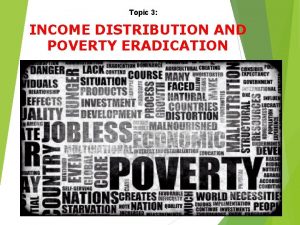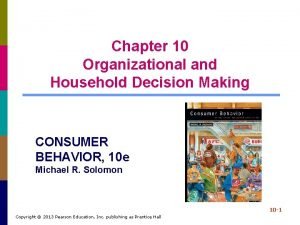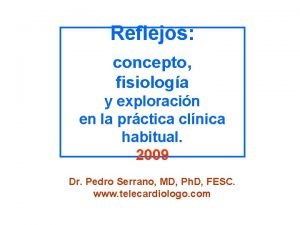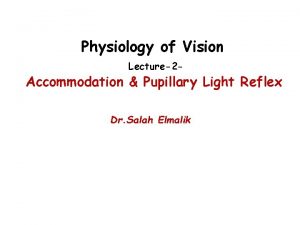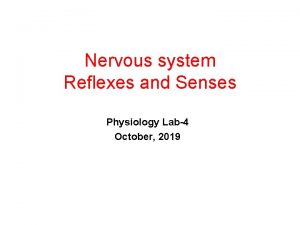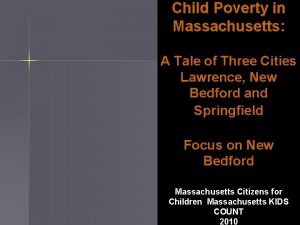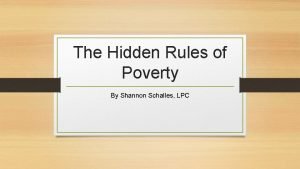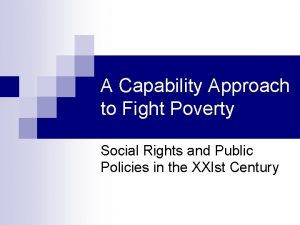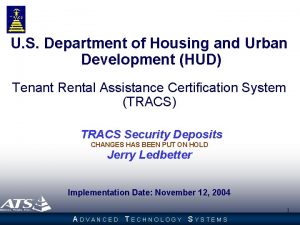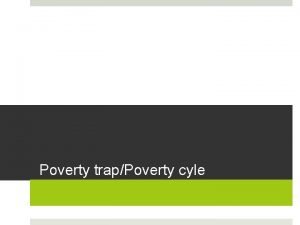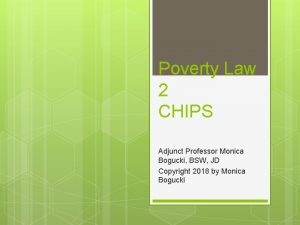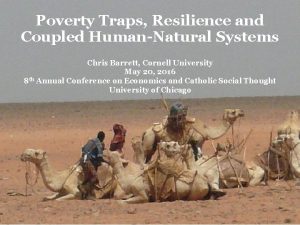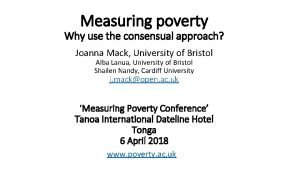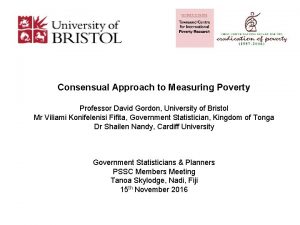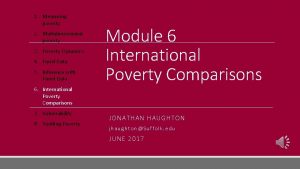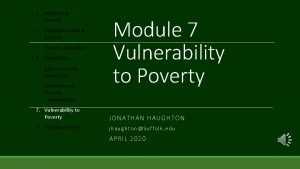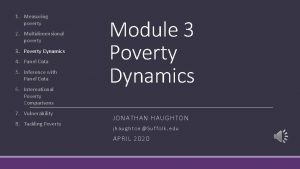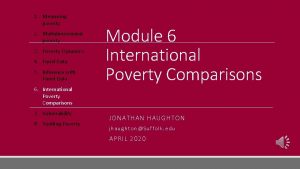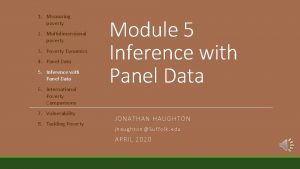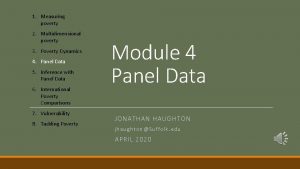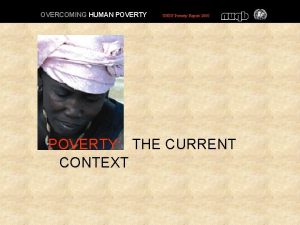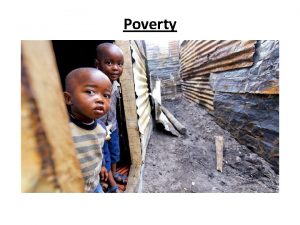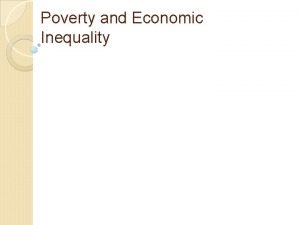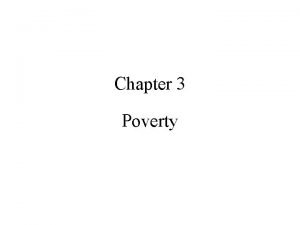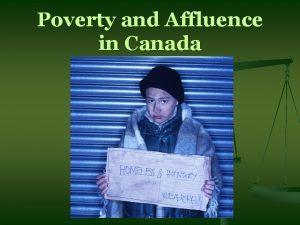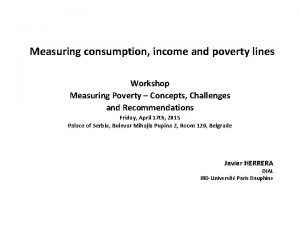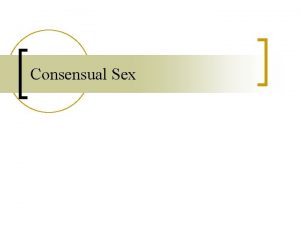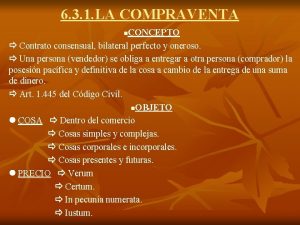Measuring poverty The foundations of the consensual approach



























- Slides: 27

Measuring poverty The foundations of the consensual approach Joanna Mack, University of Bristol j. mack@open. ac. uk University of the South Pacific Tonga 5 April 2018 www. poverty. ac. uk

Foundations of consensual approach Absolute and overall poverty In 1995 the United Nations adopted two definitions of poverty. Absolute poverty A condition characterised by severe deprivation of basic human needs, including food, safe drinking water, sanitation facilities, health, shelter, education and information. It depends not only on income but also on access to services. Overall poverty A lack of income and productive resources to ensure sustainable livelihoods; hunger and malnutrition; ill health; limited or lack of access to education and other basic services; increased morbidity and mortality from illness; homelessness and inadequate housing; unsafe environments and social discrimination and exclusion. It is also characterised by lack of participation in decision making and in civil, social and cultural life.

Foundations of consensual approach Millennium Development Goals 1 A: Extreme poverty Target Halve, between 1990 and 2015, the proportion of people whose income is less than $1. 25 a day Progress • The target was met five years ahead of the 2015 deadline. • More than 1 billion people have been lifted out of extreme poverty since 1990. • At the global level more than 800 million people are still living in extreme poverty.

Foundations of consensual approach What’s wrong with the World Bank’s $1 a day measure? • Arbitrary • Inadequate • Downplays the extent of extreme poverty • Ignores services and social support • Problematic over time • Not all income captured • Inconsistent between poor countries • Not relevant to mid and high income countries

Foundations of consensual approach Sustainable Development Goals 1: No poverty Target 1. 2 By 2030, reduce at least by half the proportion of men, women and children of all ages living in poverty in all its dimensions according to national definitions Indicators 1. 2. 1 Proportion of population living below the national poverty line, by sex and age 1. 2. 2 Proportion of men, women and children of all ages living in poverty in all its dimensions according to national definitions

Foundations of consensual approach Relative deprivation “Individuals, families and groups in the population can be said to be in poverty when they lack the resources to obtain the types of diet, participate in the activities and have the living conditions and amenities which are customary, or at least widely encouraged or approved, in the society to which they belong. ” Townsend, 1979.

Foundations of consensual approach The European Union’s definition of poverty “The poor” are those “persons, families and groups of persons whose resources (material, cultural and social) are so limited as to exclude them from the minimum acceptable way of life in the Member State in which they live” EEC, On specific Community action to combat poverty (Council Decision of 19 December, 1984)

Foundations of consensual approach Setting a minimum acceptable way of life Measures need to: • Go beyond income to look at deprivation • Reflect the experiences of the poor • Reflect the society to which they are applied • Have appropriate age-related standards • Provide a clear justification for why these indicators have been chosen • Are applicable to low, middle and high income countries • Enable some level of international comparisons

Foundations of consensual approach The concept of socially-perceived necessities Defines a minimum acceptable way of life by identifying the ‘necessities’ of life. These are identified by public opinion and not by, on the one hand, the views of experts or, on the other hand, the norms of behaviour per se. Those who have no choice but to fall below this minimum level can be said to be ‘in poverty’. Mack and Lansley, 1985

Foundations of consensual approach The necessities question In largescale surveys participants are asked for a wide range of items and activities to distinguish between: items which you think are necessary – which all adults should be able to afford and which they should not have to do without and items which may be desirable but are not necessary. Breadline Britain survey, 1983

Foundations of consensual approach Which dimensions are covered? • Social and family life • Diet • Clothing • Medical access • Accommodation & housing standards • Educational access • Household items • Financial items • Items for children

Foundations of consensual approach An enforced lack of socially-perceived necessities For each item, participants are then asked to distinguish between: Have Don’t have but don’t want Don’t have and can’t afford Breadline Britain, 1983

Foundations of consensual approach The consensual approach For a representative set of items Is it necessary/essential? No <50% think it a necessity Yes >50% think it a necessity The necessities/essentials of life Have Don’t have, don’t want NOT DEPRIVED Don’t have, can’t afford DEPRIVED

Foundations of consensual approach Allowing for non-monetary constraints For each activity, participants were asked to distinguish between: Do Don’t do but don’t want to do Don’t do and can’t afford Don’t do for any other reason Poverty and Social Exclusion, 2012

Foundations of consensual approach A lack of socially-perceived necessities For a representative set of activities Is it necessary/essential? No < 50% think it a necessity Yes >50% think it a necessity The necessities/essentials of life Do Don’t do/don’t want NOT DEPRIVED Don’t do/can’t afford Don’t do/other constraints DEPRIVED EXCLUDED

Foundations of consensual approach Consensual method surveys across the world Europe: Austria, Belgium, Bulgaria, Croatia, Cyprus, Czech Rep, Denmark, Estonia, Finland, France, Germany, Greece, Hungary, Ireland, Italy, Latvia, Lithuania, Luxembourg, Malta, Netherlands, Poland, Portugal, Romania, Slovakia, Spain, Sweden, UK Africa: Benin, South Africa, Uganda Asia: Bangladesh, Hong Kong, Japan, South Korea Oceania: Australia, Tonga, Soloman Islands, New Zealand

Foundations of consensual approach Items to reflect Necessities of Life – Solomon Islands example Clothing - Children • New properly fitting, shoes Social activities - Children • Some new, not second-hand clothes • Celebrations on special occasions such as birthdays, Christmas or religious festival Clothing -Adults • Two pairs of properly fitting shoes, including a pair of allweather shoes Social activities - Adults • To get together with friends/family for a drink/meal at least monthly • Clothes to wear for social or family occasions such as parties or special church occasions • Presents for friends or family once a year • Replace worn-out clothes by some new (not second-hand) ones • Enough money to be able to visit friends and family in hospital or other institutions Items for school age children • All school uniform and equipment required (Books, pens) • To participate in school trips and school events that costs money • A suitable place to study or do homework • Enough beds and bedding for every child in the household List of items/activities is merely indicative, and can be adapted to the particular contexts of each country

Foundations of consensual approach Is there a consensus? In all the countries that have conducted surveys using the consensual method a very high degree of consensus has been found between all groups, including: • • • Gender Age Marital status Population group Health Employment status and Occupation Education level Number of dependent children Food insecurity Housing tenure Income level Place of residence (urban and rural)

Foundations of consensual approach A consensus: South Africa By population group Percentage thinking item Essential for: All people ‘Socially perceived necessities in South Africa’, Gemma Wright, CASASP, working paper 9, 2012

Foundations of consensual approach Is there a common view of necessities: Europe Percentage thinking item ‘absolutely necessary’: Adult and household items http: //www. poverty. ac. uk/system/files/poverty/eurobarometer_heatmap. html

Foundations of consensual approach Is there a common view of necessities: a range of countries Percentage thinking item necessary/essential: Child items ¹ Uganda - Two pairs of shoes; South Africa - shoes for different activities; ² South Africa - a birthday party; ³ Uganda – Beds; ⁴ Uganda - Desk and chair for homework; ⁵ Uganda & South Africa - All fees and uniform

Foundations of consensual approach A consensus: Northern Ireland Percentage thinking item a necessity Adult and Child items PSE: UK 2012

Foundations of consensual approach Is there a consensus? Other countries In all the countries that have conducted surveys using the consensual method a very high degree of consensus has been found between all groups. Across: Gender group Health of work Age Marital status Employment status Population Occupation Nature Education level insecurity Number of dependent children Housing tenure Income level Area Food

Foundations of consensual approach A consensus: South Africa By food security Percentage thinking item Essential for: All people ‘Socially perceived necessities in South Africa’, Gemma Wright, CASASP, working paper 9, 2012

Foundations of consensual approach Are there universal human needs? The surveys suggest there is universal agreement on the need for: • Adequate levels and variety of food – two/three meals a day, meat/fish etc • Adequate levels of housing – enough beds/bedrooms, study area; heating – in colder countries; weather/wind proof housing • Adequate levels of clothing – two pairs of shoes, replacing worn out clothes • Access to health care – being able to afford medicines and medical care • Education – school uniforms, school trips, • Social obligations – visiting friends/family in hospital • Some leisure activities seen as necessities in some cultures/countries

Foundations of consensual approach An enforced lack of necessities: Tonga, Uganda, UK Items for children Tonga Uganda UK Percentage who can’t afford item Three meals a day 8% One meal with meat, fish or vegetarian equivalent daily 8% Enough beds for every child in the household Own room for children over 10 of different sexes 11% A suitable place to study or do homework² 48% 1% 3% 75% 60% 11% 10% 76% 5% New properly fitting shoes¹ 12% 71% 4% Some new not second-hand clothes 15% 63% 4% 6% 56% Participate in school trips and school events that costs money 11% 64% 8% Celebration on special occasions 17% 70% 1% All school uniform and equipment required³ ¹ Uganda - Two pairs of shoes, ² Uganda - Desk and chair for homework, ³ Uganda - All fees and uniform ‘Child poverty in Tonga’, Viliami Fifita, Shailen Nandy, David Gordon; ‘Social services delivery in Uganda’, Shailen Nandy & Marco Pomati; http: //www. poverty. ac. uk/pse-research/

Foundations of consensual approach Setting a minimum acceptable way of life The consensual method allows for measures that: • Go beyond income to look at deprivation • Reflect the experiences of the poor • Reflect the society to which they are applied • Have appropriate age-related standards • Provide a clear justification for why these indicators have been chosen • Are applicable to low, middle and high income countries • Enable some level of international comparisons
 Relative poverty
Relative poverty Accommodative purchase decision
Accommodative purchase decision Escala de reflejos de wartenberg para que sirve
Escala de reflejos de wartenberg para que sirve Nursing process is organizes in which sequence?
Nursing process is organizes in which sequence? Deciding consensual vs top down
Deciding consensual vs top down Magnocellular parvocellular
Magnocellular parvocellular Consensual reflex
Consensual reflex Result approach in measuring performance
Result approach in measuring performance What is research approach
What is research approach Waterfall strategy
Waterfall strategy Deep learning approach and surface learning approach
Deep learning approach and surface learning approach Traditional approach to systems implementation
Traditional approach to systems implementation Multiple approach-avoidance conflict
Multiple approach-avoidance conflict Difference between datagram and virtual circuit
Difference between datagram and virtual circuit Cognitive approach vs behavioral approach
Cognitive approach vs behavioral approach Cognitive approach vs behavioral approach
Cognitive approach vs behavioral approach Child poverty in massachusetts
Child poverty in massachusetts Simon moss global poverty project
Simon moss global poverty project Hidden rules of poverty
Hidden rules of poverty Situational poverty definition
Situational poverty definition Poverty proofing
Poverty proofing Poverty reduction workgroup
Poverty reduction workgroup Sandra cisneros bio
Sandra cisneros bio Ministry of housing and urban poverty alleviation
Ministry of housing and urban poverty alleviation Poverty cycle
Poverty cycle Mental model of poverty
Mental model of poverty Adjunct poverty definition
Adjunct poverty definition Types of poverty in economics
Types of poverty in economics
